Preethi Venugopala's Blog, page 18
April 19, 2017
Query Letters
Once you finish writing your novel, you have to start querying for agents, publishers to get your novel published if you do not wish to go for the self publishing/Indie publishing route.
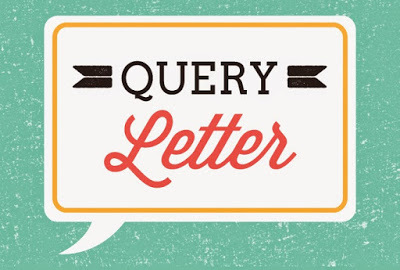 Image Source
Image Source
The main objective of your query letter is to show to the agent or the editor at the publishing house that your novel is exactly what they need.
Since the query letter is going to create the first impression about you in the agent's/ editor's mind, be sure to make your query letter stand out from the rest.
Work on it with as much effort as you put into writing your novel.
Make it crisp and to the point.
What are the elements that should be included in your query letter?
Customize: Customize the letter by addressing the agent/editor by their full name. Do not just address them as 'Dear editor', or 'Dear Jane'. Be sure to use the correct spelling of their name.Specify the Details: Some gents/ publishers are open to multiple genres of fiction and non-fiction. Make sure that you mention the genre/category, word count, title/subtitle etc.Summary: This is the most important part of the query. Write a crisp summary that generates an interest in the mind of the editor. Highlight the hook and the USP of the book. A 100-200 words is ideal for most novels.Bio: If you have a publishing history mention it. Thank you and closing.
The best way to understand this is to read a sample query letter. If you search on the internet, you can find many samples.
Check this very effective query letter here:
Sample of a Query Letter to an agent.
In India, most of the publishers, except the top few, accept direct submissions from the authors.
Here is a list of publishers in India curated by my friend and author Prity Subramanian.
In India, the number of agents are lesser compared to other countries but there are some very good agencies which accept queries from established and newbie authors from in and around India.
Here is a list of the 5 top literary agents in India.
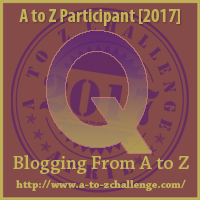
During this A-Z April Challenge, I am exploring the A-Z journey of writing a Novel with examples from Literature.
The Letter of the day is Q
Linking this post to Blogging from A-Zand Blogchatter
Have you read the Letters A, B, C, D, E, F, G, H I J K L M
 Image Source
Image SourceThe main objective of your query letter is to show to the agent or the editor at the publishing house that your novel is exactly what they need.
Since the query letter is going to create the first impression about you in the agent's/ editor's mind, be sure to make your query letter stand out from the rest.
Work on it with as much effort as you put into writing your novel.
Make it crisp and to the point.
What are the elements that should be included in your query letter?
Customize: Customize the letter by addressing the agent/editor by their full name. Do not just address them as 'Dear editor', or 'Dear Jane'. Be sure to use the correct spelling of their name.Specify the Details: Some gents/ publishers are open to multiple genres of fiction and non-fiction. Make sure that you mention the genre/category, word count, title/subtitle etc.Summary: This is the most important part of the query. Write a crisp summary that generates an interest in the mind of the editor. Highlight the hook and the USP of the book. A 100-200 words is ideal for most novels.Bio: If you have a publishing history mention it. Thank you and closing.
The best way to understand this is to read a sample query letter. If you search on the internet, you can find many samples.
Check this very effective query letter here:
Sample of a Query Letter to an agent.
In India, most of the publishers, except the top few, accept direct submissions from the authors.
Here is a list of publishers in India curated by my friend and author Prity Subramanian.
In India, the number of agents are lesser compared to other countries but there are some very good agencies which accept queries from established and newbie authors from in and around India.
Here is a list of the 5 top literary agents in India.

During this A-Z April Challenge, I am exploring the A-Z journey of writing a Novel with examples from Literature.
The Letter of the day is Q
Linking this post to Blogging from A-Zand Blogchatter
Have you read the Letters A, B, C, D, E, F, G, H I J K L M
Published on April 19, 2017 13:00
April 18, 2017
Funny Memes about Procrastination
 Image SourceI sat down in front of my laptop to write the P post and then procrastinated for hours. I couldn't decide what to write for Letter P. So I decided to make the controversial 'Procrastination' the star of my Letter P post.
Image SourceI sat down in front of my laptop to write the P post and then procrastinated for hours. I couldn't decide what to write for Letter P. So I decided to make the controversial 'Procrastination' the star of my Letter P post.Then I procrastinated again for long thinking what I should write about procrastination. Procrastination is after all the biggest wall that stands between a writer and his/her finished novel. I went surfing the internet to get some ideas, ended up watching a movie, saw a few funny videos and then slept at my desk. I realized I had a serious case of procrastination. I decided to laugh about this incurable disease.
I wish to share with you these funny memes about procrastination which today to unburden my guilt.
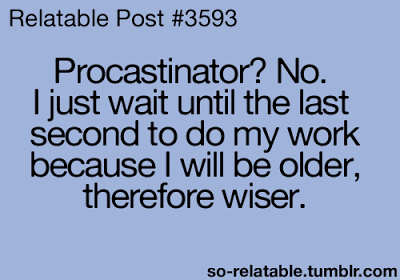 Image Source
Image SourceIn case you are not a master procrstinator, do check out this amazing course!
 Image Source
Image Source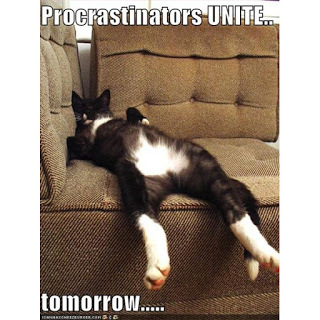
Until tomorrow, then!
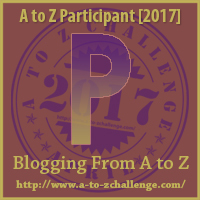
During this A-Z April Challenge, I am exploring the A-Z journey of writing a Novel with examples from Literature.
The Letter of the day is P
Linking this post to Blogging from A-Zand Blogchatter
Have you read the Letters A, B, C, D, E, F, G, H I J K L M
Published on April 18, 2017 13:00
April 17, 2017
30 Things to Do to Own Your writing Craft
The most important thing to remember while venturing into writing is to own your writing craft.
Here are 30 things to do to own your writing craft.
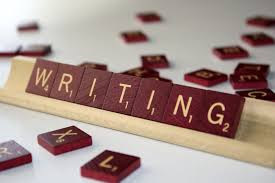 Image Source
Image SourceAs a writer, you are unique. Remember that.You have a style and voice that is your own. Develop it.You won’t be perfect in the beginning. Accept it. No one is born a writer. You learn it on the job.Writing is a craft and can be learned.Every writer tries new techniques and style to narrate their story. Learn the one that you likes best.Don’t allow haters to get to you. Haters hate, creators create.There will be people who will try to pull you down using a multitude of tactics. Ignore them. Only you know what you are capable of, so stick to learning your craft until you master it.Learn from the masters. There are numerous books on writing. Use them wisely. Don’t restrict yourself to one genre. Experiment in other genres that you like to read.Your creativity is God’s gift to you. Using your creativity for the benefit of others is your gift back to God.Stop telling yourself,’ It is too late.’Don’t wait till you make enough money and retire, to indulge in your creative dreams.Never tell yourself that your dreams don’t matter.Stop terrorizing yourself by giving life to all your fears. If you are blocked, use the morning pages to get out of it.Go on Artist dates, pamper the artist in you by visiting places where you have been wishing to go since long.Unlearn the many negative habits that come in way of your creativity.Build a writing routine.Get rid of all your negative beliefs regarding writing. The top most among them are that writers are broke, unhappy or loners.Create a sense of your own identity as a writer in your mind. Don’t allow anyone to put labels on you.Take writing advice from people you trust, those who you know have your best interests at heart and are experts in the field.Identify the crazymakers in your life. Do you have someone in your life who takes over your life by dragging you into their own problems? Avoid them.Make the blank page your friend. No matter what, show up at the page every day and transform it.Pray for guidance before you begin a project.Meditate before you sit to write.Give yourself an easily attainable word count daily target. Whatever extra you write is a bonus for your hard work. Reward yourself.Choose a writing buddy who will encourage you and hold you accountable at every step of the way.Enjoy the process of creation. Fall in love with it.
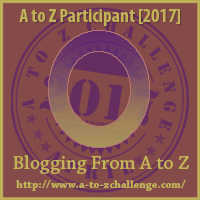
During this A-Z April Challenge, I am exploring the A-Z journey of writing a Novel with examples from Literature.
The Letter of the day is O
Linking this post to Blogging from A-Zand Blogchatter
Have you read the Letters A, B, C, D, E, F, G, H I J K L M and
Published on April 17, 2017 13:00
April 16, 2017
Names: Do They Matter?
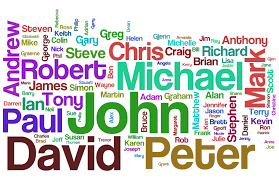 Image Source
Image SourceI asked some of my author friends how important are the names of the characters in their books to them? Do they spend agonizing hours deciding on their names?
Here are their answers.
Radhika Maira Tabrez
Some names were particularly important in ‘In the Light Of Darkness’. Because the story demanded that two of the main characters belong to a certain religion. And because I was placing the story on a fictional island, loosely modeled on Goa/Pondicherry, they also needed to have a certain ancestry in order to lend authenticity to the story. So I needed a common Indian name of Portuguese decent.
But otherwise, I rarely spend much time thinking about the names. I start with a name that deems fit at the moment and as the character develops, I am either proven right or a better name dawns on me.
Ayan Pal
Names are usually extremely important for me, though I don’t usually spend agonizing hours deciding them anymore, for I have probably done that already and have a list of names I plan to use! The names, in many ways, helps me shape up the character.
However, in Confessions on an Island the three leads, for the most part of the book, remain nameless. The names of the author and abductor are revealed in the end, while that of the island is never revealed for a reason. When you read the book, you will realize why, and in the process also hopefully get an idea about why names are so important!
Adite Banerjee
Names are usually extremely important for me, though I don’t usually spend agonizing hours deciding them anymore, for I have probably done that already and have a list of names I plan to use!
The names, in many ways, helps me shape up the character. However, in Confessions on an Island the three leads, for the most part of the book, remain nameless. The names of the author and abductor are revealed in the end, while that of the island is never revealed for a reason. When you read the book, you will realize why, and in the process also hopefully get an idea about why names are so important!
Priyanka Menon
Yes, names of characters (especially the leads) are very important. I believe this works in three ways.
a. It’s the writer’s personal choice, so invariably certain biases follow. (Think of Karan Johar and his Anjalis and Nainas, OR, Sooraj Barjatya and “Prem”)b. For the reader, the names are windows into the psyche of the character. (Every character in the Harry Potter series has a certain intended association behind her/his name, which in turn goes a long way in defining the character)c. It is also a window into the mind of the writer, for the most part.
If you want to learn more about their creative journey, read their entire interview by clicking on their names.
Do you agree that names are important?
How do you decide the names of the characters in your book?
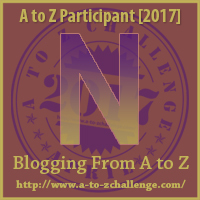
During this A-Z April Challenge, I am exploring the A-Z journey of writing a Novel with examples from Literature.
The Letter of the day is N
Linking this post to Blogging from A-Zand Blogchatter
Have you read the Letters A, B, C, D, E, F, G, H I J K L and M?
Published on April 16, 2017 13:00
April 14, 2017
A Magical Cauldron of Memories
 Image Source
Image SourceIf I could steal one thing from the magical world of Harry Potter, I would steal Albus Dumbledore’s pensieve, the magical cauldron that brings memories alive.
We can view these memories from a non-participant, third-person point of view. It fascinates me unlike anything.
More than anyone else, I think writers can use it effectively. Writers are scavengers. We dig memories.
Often, we dive into our memories to bring alive a scene in our story. There would be something in our vast experiences that can become a benchmark to build a scene or character.
When that bully in Grade six who pushed you into the mud, did he know that he will provide fodder for that memorable scene where your heroine first encounters the villain years later?
When your drunk friend puked in your living room, did she imagine the scene would become the much-needed humor relief in a tragic story you wrote?
It is in fiction that many of our life experiences get featured. Under the shroud of fiction, we can pass of anything as our creation. If any of the incidences/ persons seem familiar, it is mere coincidence dear reader.
I think that is the reason why the below declaration is mandatory for most novels/short stories.
“This is a work of fiction. Names, characters, businesses, places, events and incidents are either the products of the author’s imagination or used in a fictitious manner. Any resemblance to actual persons, living or dead, or actual events is purely coincidental.”
See how the author and publisher is lying through their teeth?
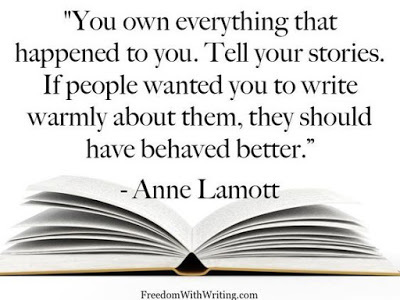 Image SourceAs Anne Lammott says, people have the responsibility to act nicely towards authors. If they didn’t behave, they live to watch the consequence.
Image SourceAs Anne Lammott says, people have the responsibility to act nicely towards authors. If they didn’t behave, they live to watch the consequence.It is as simple as that.
Since memories can sometimes be very vague, we even gloss over the worst ones.
Memories acquire the halo of goodness with the passage of time. According to the importance we give to it, it becomes modified accordingly.
Two persons may have memories about the same event in different hues. One might have hated it, the other might have loved it.
Accordingly, their memories paint these events differently. If they are writers, the scene might serve for entirely different purposes for them.
Do you use your experiences in your writing?
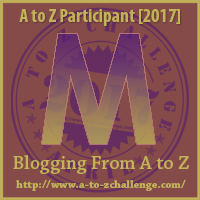
During this A-Z April Challenge, I am exploring the A-Z journey of writing a Novel with examples from Literature.
The Letter of the day is M
Linking this post to Blogging from A-Zand Blogchatter
Have you read the Letters A, B, C, D, E, F, G, H I J K and L ?
Published on April 14, 2017 13:00
April 13, 2017
Creative Writing: A Leap of Faith
 Image Source
Image SourceThe realm of creative writing demands an inevitable leap of faith. We do not worry about how or where the journey will lead us.
We are not worried about the consequences. We do not care whether the book will finally find a home in one of the publishing houses or whether it will face rejections.
We don't worry about reviews. In our daydreams, we are sure our readers will love everything that we wrote.
We don't worry about the fate of the protagonists when we begin writing. We have full faith, that it will end well. After all, all is well that ends well.
It is just the journey that matters. If we worry, we face a wall called writer's block.
When we experience the entire journey of novel writing as an act of faith, it becomes mesmerizing. The characters which had only a blurry outline, in the beginning, starts to get a solid 3-D image with every word that we write.
We string together words to make a sentence, sentences together to make a paragraph, paragraphs together to make a scene and scenes together create our chapters.
The entire process is a leap of faith. Even if we plot each and every scene, we have no way of knowing whether it will come out as vividly as we had thought it would. Yet, we write.
After producing a very crappy first draft, we sit down to polish it. Like a diligent diamond cutter who cuts away the precious diamond to make them sparkle more, we cut away redundant phrases, scenes, and even characters.
After the many drafts, when we submit it to our editor, we hope they will value your creation. We want them to handle our baby with care. We expect them to groom it without losing its essence.
We believe everything will turn out fine in the end. We would find a good publisher, readers would love our work and critics would praise our work.
Every writer is a dreamer. We create a parallel universe which is inhabited by the characters we create. We love escaping to this place which is our own perfect haven.
Is there anything more magical than this leap of faith that we writers take?
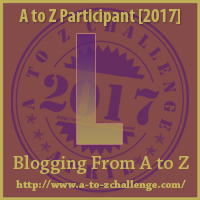
During this A-Z April Challenge, I am exploring the A-Z journey of writing a Novel with examples from Literature.
The Letter of the day is L
Linking this post to Blogging from A-Zand Blogchatter
Have you read the Letters A, B, C, D, E, F, G, H I J K?
Published on April 13, 2017 13:00
April 12, 2017
Kill Your Darlings!
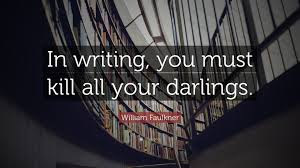 Image SourceThis quote by William Faulkner urges the writer to edit out phrases, characters, scenes, paragraphs or sentences that are their darlings when they don't serve a purpose.
Image SourceThis quote by William Faulkner urges the writer to edit out phrases, characters, scenes, paragraphs or sentences that are their darlings when they don't serve a purpose.Stephen King uses this quote in his book ‘On Writing’ to emphasize this major editing technique.
Writers often fall in love with their creation. Many of us consider our books as our babies.
When an editor asks you to cut some of your favorite scenes, you might raise a hue and cry. It is one terrible thing to do.
You might even be tempted to look for another opinion.
But the reality is that removing our darlings from the manuscript often strengthens our characters and plot.
It also tightens the prose thus improving the overall quality of our writing.
What are the darlings you can edit out without much thought from your manuscript?
Put on your thinking cap and weed out the weak characters, irrelevant plot lines, flowery metaphors, and similes.Check whether the many backstories actually matter. Would your story work fine if you cut your prologue?Are there pointless scenes in your book that isn’t interesting at all?Is your first chapter relevant? Read through your first chapter. By the time you finish your manuscript, the first chapter might require a thorough revamp as the story might have changed from what you initially had in mind.
While you kill off your darlings, make sure you are doing it in a separate copy of your manuscript.
You never know, you might want to revive a few of your darlings later on.
Another way authors kill their darlings is by killing off one of their strong characters.
Seems bizarre, right?
For example, author George R R Martin kills off many of his stronger and well-loved characters in his international bestselling series of epic fantasy novels, A Song of Ice and Fire , adapted by HBO into the dramatic series Game of Thrones .
JK Rowling kills at least one character off in each of her Harry Potter books.
I died a little when Dumbledore died.
The deaths of Sirius, Mad eyed moody, Hedwig, Dobby, Tonks and Lupin, Snape, Fred and many other characters make the books so much poignant and un-putdownable. We empathize with the loss faced by our favorites.
By killing off these darlings, J.K Rowling ensured they will live in our hearts forever.
And not to forget, don’t we all love Romeo and Juliet?
Now the big question! Will you be ready to kill your darlings?
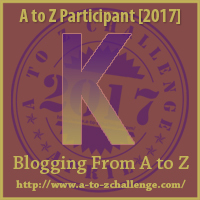
During this A-Z April Challenge, I am exploring the A-Z journey of writing a Novel with examples from Literature.The Letter of the day is H
Linking this post to Blogging from A-Zand Blogchatter
Have you read the Letters A, B, C, D, E, F, G, H I J ?
Published on April 12, 2017 12:30
April 11, 2017
Apps to Jot Down those Ideas
I have those days when ideas after ideas for stories, blog post, and novels bombard me.
The very next day, I struggle to meet my writing target for the day. Then there are days when I have a very vivid dream which could be converted into a good short story. By the time I find time to sit down and write, the images have become blurred and I don’t remember much about what I had seen.
So what can be done to capture these elusive creative ideas? I have found a solution.
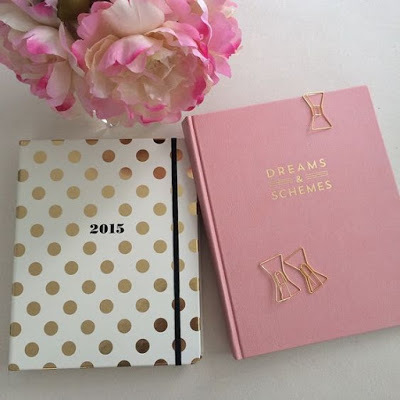 Image Source
Image Source
Now, I keep a small notebook in my bag to jot down the ideas that pop up randomly. I have apps on my phone where I can jot down ideas. I also keep a dream journal where I note my dreams. I don't write down every dream, only the ones I find interesting.
Evernote is one app that allows you to save notes, links and also help bookmark websites. It is kind of your secret box where you can keep all your magnificent ideas safe and organized.
It also helps while you are doing research for a write-up. The various links and data that you collect can be saved in one single folder, thus making it easy for you to re-check the facts or prepare your final draft.
The Notes app on my iPhone and the Quickmemo+ app in my LGV20 are other places where I note interesting tidbits that catch my eye. These can be random phrases from a newspaper, a dialogue overheard or a real-life story which had touched your heart.
Some other options to jot down your ideas are Microsoft OneNote, Simplenote, and Google Keep.
If you like hearing the sound of a typewriter when you type those ideas, HanX Writer developed by actor Tom Hanks, is the app you should use. Linking the app currently available only for the ios platform. If you google you can find the android version as well.
Make sections/folders like story ideas, blogpost ideas, dialogues, phrases, interesting words etc while you store them.
The best thing about these apps are that they are free and user friendly. Some of them do have premium versions, but the free versions itself is wonderful.
When I run out ideas to write a blogpost or a story, I go through these notes. Mostly, it triggers a new blogpost or story idea.
It always helps if you categorize these notes that you jot down. Otherwise, it will seem like a clutter that doesn’t make sense.
Now that I have adopted this technique, I don’t lose many of those creative ideas that come to me. I receive them with happiness, jot down and keep them secure in my apps or notebook.
PS: If any one of you are thinking about stealing my pocket notebook, may God save you. Not only will you face my wrath, you will not be able to make head or tail of it. It is written in a special code that only I can crack.
The very next day, I struggle to meet my writing target for the day. Then there are days when I have a very vivid dream which could be converted into a good short story. By the time I find time to sit down and write, the images have become blurred and I don’t remember much about what I had seen.
So what can be done to capture these elusive creative ideas? I have found a solution.
 Image Source
Image SourceNow, I keep a small notebook in my bag to jot down the ideas that pop up randomly. I have apps on my phone where I can jot down ideas. I also keep a dream journal where I note my dreams. I don't write down every dream, only the ones I find interesting.
Evernote is one app that allows you to save notes, links and also help bookmark websites. It is kind of your secret box where you can keep all your magnificent ideas safe and organized.
It also helps while you are doing research for a write-up. The various links and data that you collect can be saved in one single folder, thus making it easy for you to re-check the facts or prepare your final draft.
The Notes app on my iPhone and the Quickmemo+ app in my LGV20 are other places where I note interesting tidbits that catch my eye. These can be random phrases from a newspaper, a dialogue overheard or a real-life story which had touched your heart.
Some other options to jot down your ideas are Microsoft OneNote, Simplenote, and Google Keep.
If you like hearing the sound of a typewriter when you type those ideas, HanX Writer developed by actor Tom Hanks, is the app you should use. Linking the app currently available only for the ios platform. If you google you can find the android version as well.
Make sections/folders like story ideas, blogpost ideas, dialogues, phrases, interesting words etc while you store them.
The best thing about these apps are that they are free and user friendly. Some of them do have premium versions, but the free versions itself is wonderful.
When I run out ideas to write a blogpost or a story, I go through these notes. Mostly, it triggers a new blogpost or story idea.
It always helps if you categorize these notes that you jot down. Otherwise, it will seem like a clutter that doesn’t make sense.
Now that I have adopted this technique, I don’t lose many of those creative ideas that come to me. I receive them with happiness, jot down and keep them secure in my apps or notebook.
PS: If any one of you are thinking about stealing my pocket notebook, may God save you. Not only will you face my wrath, you will not be able to make head or tail of it. It is written in a special code that only I can crack.
Published on April 11, 2017 12:30
April 10, 2017
In Medias Res Explained Using Examples from Literature
‘In medias res’ is Latin for ‘in the midst of things'.
 Source
Source
This is a narrative technique where the story begins at a very interesting and crucial point in the plot.
The Greek epics, the Iliad and the Odyssey are the oldest examples of this particular technique.
The Odyssey starts at a point when most of Odysseus' journey is completed. Homer then narrates the backstory using flashbacks and the reader gets to know about the interesting characters he had met along the way.
Stephenie Meyer opens each book of her Twilight saga series with a preface describing a scene that happens near the end of the story.
“I’d never given much thought to how I would die – though I’d had reason enough in the last few months – but even if I had, I would not have imagined it like this.” -(excerpt from Twilight Book One, Stephenie Meyer)
Most often this is the one scene that sets the story off in the mind of the author. The scene will haunt him/her until he writes it down. Once the scene is in place, the writer can think about the various backstories that might have led the character to this particular scene.
The exposition part, where the various characters are introduced, which is how a novel usually begins is skipped to a later part or done slowly as the novel progresses. The benefit of this method is that the reader is instantly hooked into the story.
In Shakespeare’s Hamlet, the King of Denmark has already been killed when the story begins. If Shakespeare had begun the story somewhere before the King is killed, perhaps the reader wouldn’t have been hooked instantly. But as it is Shakespeare, we can’t be so sure. He would have found another method to pique the curiosity of the reader.
This sort of troupe works successfully in movies and short stories as well.
Some of the movies that have used this technique effectively are Shawshank Redemption, The Pirates of the Caribbean, Forest Gump, Inception, to name a few.
Have you read any book recently where this technique was used effectively?
Do share the name in the comments.
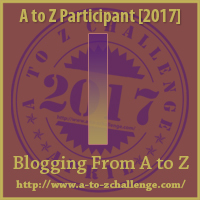
During this A-Z April Challenge, I am exploring the A-Z journey of writing a Novel with examples from Literature.The Letter of the day is H
Linking this post to Blogging from A-Zand Blogchatter
Have you read the Letters A, B, C, D, E, F, G, H?
 Source
SourceThis is a narrative technique where the story begins at a very interesting and crucial point in the plot.
The Greek epics, the Iliad and the Odyssey are the oldest examples of this particular technique.
The Odyssey starts at a point when most of Odysseus' journey is completed. Homer then narrates the backstory using flashbacks and the reader gets to know about the interesting characters he had met along the way.
Stephenie Meyer opens each book of her Twilight saga series with a preface describing a scene that happens near the end of the story.
“I’d never given much thought to how I would die – though I’d had reason enough in the last few months – but even if I had, I would not have imagined it like this.” -(excerpt from Twilight Book One, Stephenie Meyer)
Most often this is the one scene that sets the story off in the mind of the author. The scene will haunt him/her until he writes it down. Once the scene is in place, the writer can think about the various backstories that might have led the character to this particular scene.
The exposition part, where the various characters are introduced, which is how a novel usually begins is skipped to a later part or done slowly as the novel progresses. The benefit of this method is that the reader is instantly hooked into the story.
In Shakespeare’s Hamlet, the King of Denmark has already been killed when the story begins. If Shakespeare had begun the story somewhere before the King is killed, perhaps the reader wouldn’t have been hooked instantly. But as it is Shakespeare, we can’t be so sure. He would have found another method to pique the curiosity of the reader.
This sort of troupe works successfully in movies and short stories as well.
Some of the movies that have used this technique effectively are Shawshank Redemption, The Pirates of the Caribbean, Forest Gump, Inception, to name a few.
Have you read any book recently where this technique was used effectively?
Do share the name in the comments.

During this A-Z April Challenge, I am exploring the A-Z journey of writing a Novel with examples from Literature.The Letter of the day is H
Linking this post to Blogging from A-Zand Blogchatter
Have you read the Letters A, B, C, D, E, F, G, H?
Published on April 10, 2017 12:00
Hook the Reader using the Narrative Hook
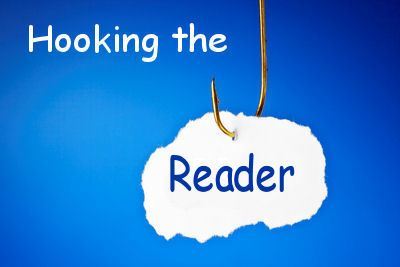 Image SourceHave you noticed how certain books hook us to it right from the first line or chapter? The author cleverly lays out interesting tidbits from the story capturing our interest.
Image SourceHave you noticed how certain books hook us to it right from the first line or chapter? The author cleverly lays out interesting tidbits from the story capturing our interest.Take, for example, these lines from the first book in the Harry Potter series.
“Mr. and Mrs. Dursley of number four, Privet Drive, were proud to say that they were perfectly normal, thank you very much.” -(excerpt from Harry Potter and the sorcerer’s stone by J. K Rowling)
What do they convey to the reader?It hints that something is not definitely normal about them. Many questions emerge in the mind of the reader.Who are these Dursleys?Why are they pretending to be normal which they are perhaps not?What is about to happen?
You can see how a single sentence created a hook that is definitely going to make the reader turn the pages. This literary technique is called as the narrative hook or simply the hook.
The best way to create a narrative hook is to pique the curiosity of the reader right from the beginning. You can begin the narrative with a funny advice, an interesting anecdote, a bold statement or a contradictory statement which would catch the attention of the reader.
Some readers, like me, read to enjoy the beauty of narration. If it begins with a sentence or paragraph that is beautifully written, the book quickly catches my attention.
Some authors make the first chapter of the book so interesting that the reader is curious. What will happen to the characters now? How will this dilemma be solved?
Check my post about magnificent first sentences and paragraphs examples from literature. You can see that they are excellent narrative hooks. They raise many questions in the mind of the reader.
Look at these lines from the final book of the Harry Potter series.
The two men appeared out of nowhere, a few yards apart in the narrow, moonlit lane. ~ (excerpt from Harry Potter and the Deathly Hallows, J.K Rowling)
When the reader reads these lines, he immediately wants to know who these men are? Being a series, they would want to know what roles are they going to play in the book. Further descriptions answer these questions but keep on raising further questions.
The narrative hook works best when it is spread throughout the book raising questions that will make the reader think. Sometimes a single sentence can do the trick but sometimes an entire chapter brings together various facets of a story that grips the interest of the reader.
When you read a book next time, look out for such narrative hooks.
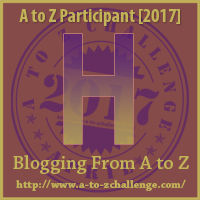
During this A-Z April Challenge, I am exploring the A-Z journey of writing a Novel with examples from Literature.The Letter of the day is H
Linking this post to Blogging from A-Zand Blogchatter
Have you read the Letters A, B, C, D, E, F, G?
Published on April 10, 2017 00:13



